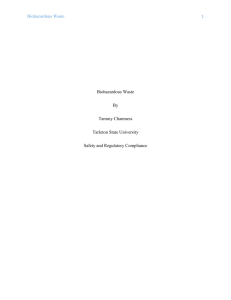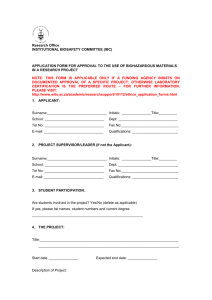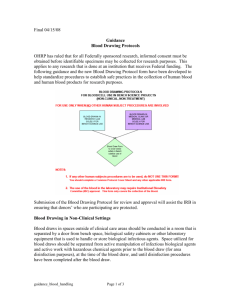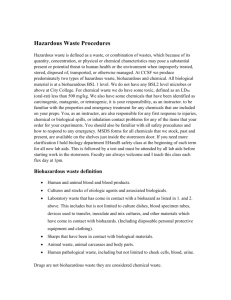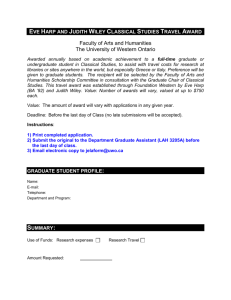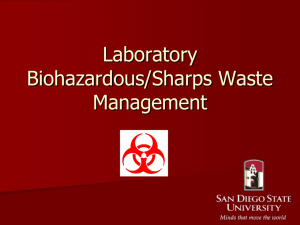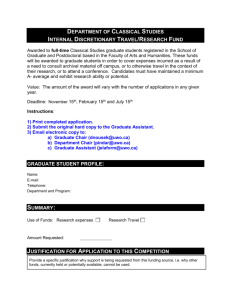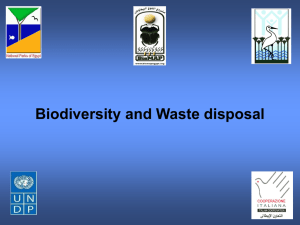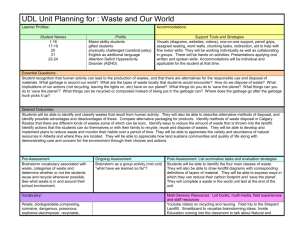Biohazardous Material Checklist | Waste Management
advertisement
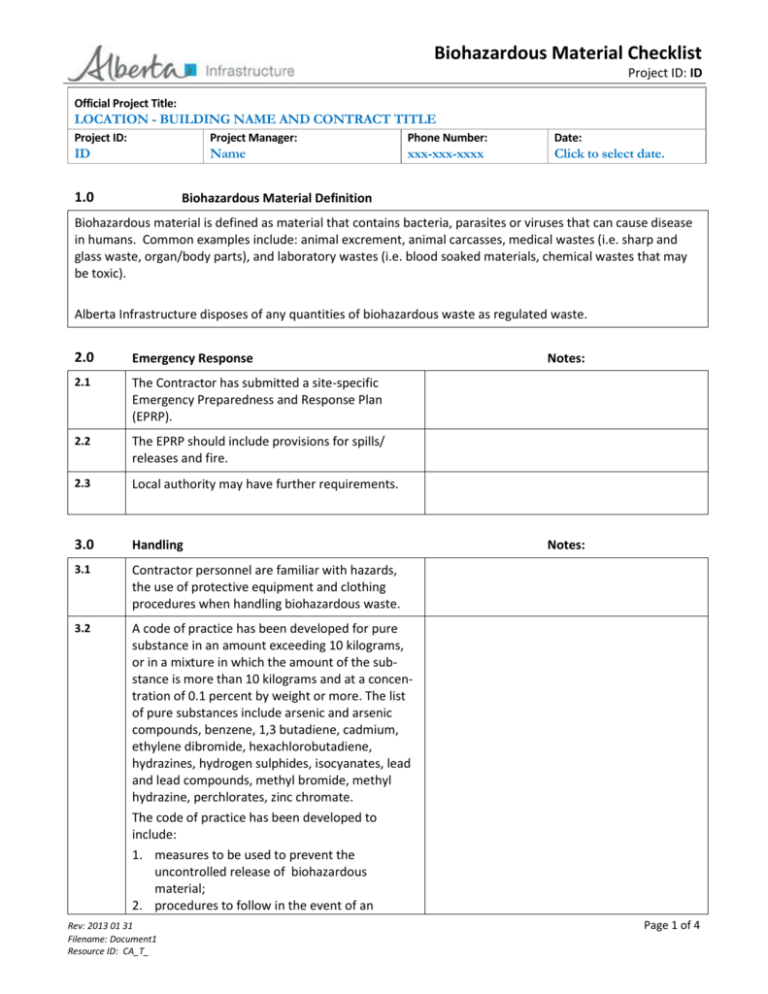
Biohazardous Material Checklist Project ID: ID Official Project Title: LOCATION - BUILDING NAME AND CONTRACT TITLE Project ID: Project Manager: Phone Number: Date: ID Name xxx-xxx-xxxx Click to select date. 1.0 Biohazardous Material Definition Biohazardous material is defined as material that contains bacteria, parasites or viruses that can cause disease in humans. Common examples include: animal excrement, animal carcasses, medical wastes (i.e. sharp and glass waste, organ/body parts), and laboratory wastes (i.e. blood soaked materials, chemical wastes that may be toxic). Alberta Infrastructure disposes of any quantities of biohazardous waste as regulated waste. 2.0 Emergency Response 2.1 The Contractor has submitted a site-specific Emergency Preparedness and Response Plan (EPRP). 2.2 The EPRP should include provisions for spills/ releases and fire. 2.3 Local authority may have further requirements. 3.0 Handling 3.1 Contractor personnel are familiar with hazards, the use of protective equipment and clothing procedures when handling biohazardous waste. 3.2 A code of practice has been developed for pure substance in an amount exceeding 10 kilograms, or in a mixture in which the amount of the substance is more than 10 kilograms and at a concentration of 0.1 percent by weight or more. The list of pure substances include arsenic and arsenic compounds, benzene, 1,3 butadiene, cadmium, ethylene dibromide, hexachlorobutadiene, hydrazines, hydrogen sulphides, isocyanates, lead and lead compounds, methyl bromide, methyl hydrazine, perchlorates, zinc chromate. The code of practice has been developed to include: 1. measures to be used to prevent the uncontrolled release of biohazardous material; 2. procedures to follow in the event of an Rev: 2013 01 31 Filename: Document1 Resource ID: CA_T_ Notes: Notes: Page 1 of 4 Biohazardous Material Checklist Project ID: ID 3.0 Handling Notes: uncontrolled release; and 3. storage, handling, use and disposal of biohazard material. 4.0 Packaging 4.1 Bird excrement, carcasses and dry biohazardous waste can be contained in plastic disposal bags. See Master Specifications (Special Construction Division 13) for Bioahazardous Precautions. 4.2 Needles are contained in a puncture resistant container. 4.3 Medical wastes and laboratory wastes (typically wet) can be contained in impervious sealed containers. 4.4 Containers for biomedical waste must be colour– coded as shown in Table 1 and labelled with biohazard symbol. Table 1: Colour-coding of Waste Containers by Waste Type. Waste Type Colour-coding Human Anatomical Red Animal Waste Orange Microbial Laboratory Waste Yellow Human Blood and Body Fluid Waste Yellow Waste Sharps Yellow 5.0 Temporary Waste Storage 5.1 Signage is posted in temporary biohazardous storage areas. Temporary biohazardous storage areas are secured and only accessible to authorized personnel. 5.2 Biohazardous wastes are segregated at their point of origin and are differentiated from solids wastes which include: soiled dressings, sponges, surgical drapes, lavage tubes, casts, catheters, disposable gloves, speciment containers and lab coats/aprons. Rev: 2013 01 31 Filename: Document1 Resource ID: CA_T_ Notes: Notes: Page 2 of 4 Biohazardous Material Checklist Project ID: ID 5.0 Temporary Waste Storage 5.3 Biohazardous material storage sites are equipped, designed, constructed and operated with the following: Occupational Health and Safety Code, Chemical Hazards, Biological Hazards, General Safety Precautions and Harmful Substances maintained so that surface run-off water cannot enter the secondary containment system Notes: Incompatible hazardous wastes are stored in such a manner that there is no contact between them, even in the event of a release. 5.4 Absorbent materials for clean-up are near the biohazardous material storage site. 5.5 All biomedical waste must be refrigerated at 4 degrees Celsius or lower if stored for more than 4 days. Contingency plans must be prepared for storing refrigerated biomedical waste if excess waste is produced, or if either refrigeration or disposal facilities or equipment become inoperative. 6.0 Transportation 6.1 Persons transporting or handling dangerous goods have valid and current TDG certification. 6.2 Contractor transporting hazardous waste has correct TDG placarding on vehicles. 6.3 Contractor responsible to provide required manifests. Project Manager to provide generator number. 6.4 Emergency response kit required on transportation vehicle. 7.0 Disposal 7.1 Biohazardous waste has been disposed of by a licensed biohazardous waste disposal facility (to be verified by copy of manifest). 8.0 Records 8.1 Copy of Shipping documents and manifests for transportation of waste. Rev: 2013 01 31 Filename: Document1 Resource ID: CA_T_ Notes: Notes: Notes: Page 3 of 4 Biohazardous Material Checklist Project ID: ID 8.2 Copy of disposal certificate from biohazardous disposal facility. 8.3 Copy of EPRP. 9.0 Reportable Limits 9.1 Contractor reports all spills or releases of any quantities to Alberta Infrastructure. 9.2 As the majority of biohazardous waste is likely to be Class 6 a spill or release, from the transport, exceeding 5 kg or 5 L of toxic substances (Class 6.1) or 1 kg or 1 L of infectious substances (Class 6.2) is reportable to Alberta Transportation and the local police. Rev: 2013 01 31 Filename: Document1 Resource ID: CA_T_ Notes: Page 4 of 4
